Unearthing Egypt’s Golden Legacy: Geophysical Insights and New Opportunities in the Central Eastern Desert
Abstract
1. Introduction
2. Geologic and Tectonic Settings
- Precambrian Basement Complex: The Eastern Desert is primarily composed of Precambrian rocks, which are among the oldest on Earth, dating back over 600 million years. These rocks include gneisses, schists, and migmatites, which form the backbone of the region’s geological structure.
- Ophiolites: These are fragments of ancient oceanic crust and upper mantle that have been thrust onto the continental crust. The Eastern Desert hosts some of the world’s best-preserved ophiolite sequences, which provide insights into the processes of plate tectonics and the formation of oceanic crust.
- Granitoids: Large bodies of intrusive igneous rocks, such as granites and granodiorites, are prevalent. These granitoids intruded during various tectonic events and are crucial for understanding the tectono-thermal evolution of the region.
- Sedimentary Cover: Overlying the Precambrian basement are sedimentary rocks ranging from the Paleozoic to the Cenozoic eras. These include sandstones, limestones, and shales, which provide evidence of ancient environments and the geological history of the area.
- Mountain Ranges: The Red Sea Hills dominate the landscape, with peaks often exceeding 2000 m. These mountains are dissected by numerous wadis (dry riverbeds) that channel occasional rainfall towards the Nile or the Red Sea.
- Desert Plains: Interspersed between the mountain ranges are expansive desert plains and plateaus. These areas are typically barren, covered with gravel and occasional dunes.
- Red Sea Coastline: The eastern boundary of the desert is marked by the Red Sea coastline, which features coral reefs, lagoons, and small islands. The coastal region is geologically active, with ongoing rifting and volcanic activity.
- Wadis: These dry river valleys are essential geographical features, acting as natural routes through the mountains and providing the only sources of surface water during rare rain events.
- Precambrian Units: These are the oldest rocks, forming the basement complex. They include high-grade metamorphic rocks such as gneisses and schists, and igneous rocks like granites and diorites.
- Paleozoic to Mesozoic Sedimentary Rocks: these overlie the Precambrian basement and include formations like the Cambrian sandstone, which is important for understanding the region’s sedimentary history and paleoenvironment.
- Cenozoic Deposits: The youngest rocks in the Eastern Desert are the Cenozoic sedimentary deposits, including Tertiary limestones and Quaternary alluvial deposits. These provide insights into more recent geological processes and climatic conditions.
3. Methodology
3.1. Reduction to the Pole (RTP)
3.2. Radially Averaged Power Spectrum of RTP Data
3.3. Vertical Derivative
3.4. Regional and Residual Maps
3.5. Edge Detection Methods
- The Total Horizontal Gradient (THG) method calculates the horizontal gradient of the magnetic field. This is achieved by taking the gradient in both the x and y directions and combining them. This method is effective for highlighting linear features, such as faults and dykes, as high gradients indicate abrupt changes in magnetization. The following formula is used to calculate it:
- Tilt Derivative (TDR) is the arctangent of the ratio of the vertical derivative to the horizontal gradient of the magnetic field. This method normalizes the magnetic anomalies, making it easier to identify edges, especially in areas with variable magnetic intensity. The following formula is used to calculate it:
- Analytical Signal (AS) is derived from the combination of the horizontal and vertical derivatives of the magnetic field. This method provides a clear representation of the location of the source edges and is independent of the magnetization direction, making it robust for edge detection. The following formula is used to calculate it:
- The Vertical Derivative (VD) method amplifies short-wavelength features by calculating the rate of change of the magnetic field in the vertical direction. This is useful for enhancing the visibility of shallow structures and distinguishing between closely spaced features [46].
3.6. K, Th, and eU Maps
3.7. Hydrothermal Alteration Zones Map from K/Th
3.8. Radiometric Ternary Map
4. Geophysical Data Analysis
4.1. Aeromagnetic Data Analysis
4.2. Radiometric (K, eTh and eU) Data Analysis
4.2.1. Hydrothermal Alteration Inferred from the K/eTh Ratio
4.2.2. The Radiometric Ternary Map
5. Results and Discussion
6. Conclusions
Author Contributions
Funding
Data Availability Statement
Acknowledgments
Conflicts of Interest
References
- Jenkin, G.R.T.; Lusty, P.A.J.; McDonald, I.; Smith, M.P.; Boyce, A.J.; Wilkinson, J.J. Ore Deposits in an Evolving Earth. Geol. Soc. Lond. Spec. Publ. 2015, 393, 265–276. [Google Scholar] [CrossRef]
- Available online: https://www.gold.org/goldhub/esg/gold-and-climate-change-research (accessed on 26 July 2024).
- Idoine, N.E.; Raycraft, E.R.; Price, F.; Hobbs, S.F.; Deady, E.A.; Everett, P.; Shaw, R.A.; Evans, E.J.; Mills, A.J. World Mineral Production 2017–21; British Geological Survey: Nottingham, UK, 2023; 98p. [Google Scholar]
- Khedr, M.Z.; Abo Khashaba, S.M.; Takazawa, E.; Hassan, S.M.; Azer, M.K.; El-Shibiny, N.H.; Abdelrahman, K.; Ichiyama, Y. Genesis of Rare Metal Granites in the Nubian Shield: Tectonic Control and Magmatic and Metasomatic Processes. Minerals 2024, 14, 522. [Google Scholar] [CrossRef]
- El-Raouf, A.A.; Doğru, F.; Abdelrahman, K.; Fnais, M.S.; El Manharawy, A.; Amer, O. Using Airborne Geophysical and Geochemical Methods to Map Structures and Their Related Gold Mineralization. Minerals 2023, 13, 237. [Google Scholar] [CrossRef]
- Mansour, S.; Gharib, M.A.; Hasebe, N.; Abdelrahman, K.; Fnais, M.S.; Tamura, A. Tectonic evolution of the Gabal Loman area, North Eastern Desert, Egypt: Implications from low-temperature multithermochronometry on the Arabian-Nubian shield. Front. Earth Sci. 2023, 11, 1193692. [Google Scholar] [CrossRef]
- Mansour, S.; Hasebe, N.; Khedr, M.Z.; Tamura, A.; Shehata, A.A. Tectonic-Thermal Evolution of the Wadi El-Dahal Area, North Eastern Desert, Egypt: Constraints on the Suez Rift Development. Minerals 2023, 13, 1021. [Google Scholar] [CrossRef]
- El-Wardany, R.M.; Jiao, J.; Zoheir, B.; Kumral, M.; Kaya, M.; Abdelnasser, A. Post-Subduction Granite Magmatism and Gold-Sulfide Mineralization in the Abu Zawal (Fatira) Area, Eastern Desert, Egypt. Minerals 2023, 13, 489. [Google Scholar] [CrossRef]
- Geological Map of Sinai, A.R.E. Sheet No. 5, Scale 1:250,000; Egyptian Geological Survey and Mining Authority (EGSMA): Cairo, Egypt, 1994. [Google Scholar]
- Klemm, D.; Klemm, R.; Murr, A. Gold of the Pharaohs—6000 years of gold mining in Egypt and Nubia. J. Afr. Earth Sci. 2001, 33, 643–659. [Google Scholar] [CrossRef]
- Elkhateeb, S.; Abdellatif, M. Delineation potential gold mineralization zones in a part of Central Eastern Desert, Egypt using Airborne Magnetic and Radiometric data. NRIAG J. Astron. Geophys. 2018, 7, 361–376. [Google Scholar] [CrossRef]
- Redwan, M. Geochemical and mineralogical characteristics of some gold mine tailings in the Eastern Desert of Egypt. Front. Earth Sci. 2022, 16, 906–915. [Google Scholar] [CrossRef]
- Safwat, S.G.; Hassan, D.; Tharwat, A.A.; Mohamed, F.S.; Khalil, I.K.; Mohamed, A.S. Aeromagnetic and Landsat-8 data interpretation for structural and hydrothermal alteration mapping along the Central and Southern Eastern Desert boundary, Egypt. Egypt. J. Remote Sens. Space Sci. 2022, 25, 11–20. [Google Scholar] [CrossRef]
- El-Feky, M.G.; El-Tokhi, M.A.; El-Hadidy, M.A. Gold exploration in the Eastern Desert of Egypt using Landsat-8 data and spectral analysis techniques. Arab. J. Geosci. 2019, 12, 426. [Google Scholar]
- Abd El-Wahed, M.; Zoheir, B.; Pour, A.B.; Kamh, S. Shear-Related Gold Ores in the Wadi Hodein Shear Belt, Southeastern Desert of Egypt: Analysis of Remote Sensing, Field and Structural Data. Minerals 2021, 11, 474. [Google Scholar] [CrossRef]
- Gaber, G.M.; Saleh, S.; Kotb, A. Integrating radiometric and aeromagnetic data for assessment of geothermal potential: A case study in Central Eastern Desert, Egypt. Acta Geophys. 2024. [Google Scholar] [CrossRef]
- Gaber, G.M.; Saleh, S.; Kotb, A. 3D Gravity and magnetic inversion modelling for geothermal assessment and temperature modelling in the central eastern desert and Red Sea, Egypt. Sci. Rep. 2024, 14, 15266. [Google Scholar] [CrossRef] [PubMed]
- Gaber, G.M.; Saleh, S.; Kotb, A. Investigating geothermal resources in the Central Eastern Desert of Red Sea, Egypt, using aeromagnetic data. J. Earth Syst. Sci. 2024, 133, 137. [Google Scholar] [CrossRef]
- Shebl, A.; Abdellatif, M.; Elkhateeb, S.O.; Csámer, Á. Multisource Data Analysis for Gold Potentiality Mapping of Atalla Area and Its Environs, Central Eastern Desert, Egypt. Minerals 2021, 11, 641. [Google Scholar] [CrossRef]
- Basem, A.Z.; Peter, R.J.; Richard, J.G.; Dietrich, D.K. Orogenic gold in the Egyptian Eastern Desert: Widespread gold mineralization in the late stages of Neoproterozoic orogeny. Gondwana Res. 2019, 75, 184–217. [Google Scholar] [CrossRef]
- Abdelrady, M.; Elhadek, H.; Abdelmoneim, M.; Saleh, A. Orogenic lode-gold deposits and listvenization processes in the El-Barramiya area, Eastern Desert, Egypt. Environ. Earth Sci. 2023, 82, 420. [Google Scholar] [CrossRef]
- Abdel-Monem, A.A.; Abdel-Kader, Z.M.; Mansour, S.L.; Hassanein, S.M.M.; Mohamed, N.A.A. Petrography and geochemistry of the tectonic mélange rocks, El-Bakriya District, Central Eastern Desert, Egypt. In Proceedings of the 5th International Conference on Geochemistry Alexandria University, Alexandria, Egypt, 12–13 September 2001; pp. 251–277. [Google Scholar]
- Ahmed, N.A. Petrologic, Mineralogic and Geochemical Studies of the Basement Rocks and Associated Mineralizations of El-Bakriya Area, Central Eastern Desert, Egypt. Ph.D. Thesis, Cairo University, Giza, Egypt, 1999; p. 341. [Google Scholar]
- Shackleton, R.M.; Ries, A.C.; Graham, R.H.; Fitches, W.R. Late Precambrian ophiolitic mélange in the Eastern Desert of Egypt. Nature 1980, 285, 472–474. [Google Scholar] [CrossRef]
- El-Bialy, M.Z. Precambrian Basement Complex of Egypt. In The Geology of Egypt. Regional Geology Reviews; Hamimi, Z., El-Barkooky, A., Martínez Frías, J., Fritz, H., Abd El-Rahman, Y., Eds.; Springer: Cham, Switzerland, 2020. [Google Scholar] [CrossRef]
- Stern, R.J. The Najd Fault System, Saudi Arabia and Egypt: A Late Precambrian rift-related transform system. Tectonics 1985, 4, 497–511. [Google Scholar] [CrossRef]
- El-Gaby, S. Integrated evolution and rock classification of the Pan African belt in Egypt. In Proceedings of the First Symposium on the Classification of the Basement Complex of Egypt, Assiut, Egypt, 16–17 February 2005. [Google Scholar]
- El Gaby, S.; List, F.K.; Tehrani, R. Geology evolution and metallogenesis of the Pan-African belt in Egypt. In The Pan-African Belt of Northeast Africa and Adjacent Areas. Earth Evolution Sciences; El-Gaby, S., Greiling, R.O., Eds.; View-egerlag: Berlin, German, 1988; pp. 17–68. [Google Scholar]
- El-Amin, H. Radiometric and Geological Investigations of El-Bakriya Area, Eastern Desert, Egypt. Ph.D. Thesis, Faculty of Science, Cairo University, Cairo, Egypt, 1975. [Google Scholar]
- Said, A. Petrology and Structure of the Barramiya Area with Special Emphasis on the Gold Mineralization, Eastern Desert, Egypt. Master’s Thesis, Cairo University, Cairo, Egypt, 2006. [Google Scholar]
- Fowler, A.R.; Hamimi, Z. Structural and Tectonic Framework of Neoproterozoic Basement of Egypt: From Gneiss Domes to Transpression Belts. In The Geology of Egypt. Regional Geology Reviews; Hamimi, Z., El-Barkooky, A., Martínez Frías, J., Fritz, H., Abd El-Rahman, Y., Eds.; Springer: Cham, Switzerland, 2020. [Google Scholar] [CrossRef]
- Habib, M.E. Arc-ophiolites in the Pan-African basement between Meatiq and Abu Furad, Eastern Desert, Egypt. Bull. Fac. Sci. Assiut. Univ. 1987, 16, 241–283. [Google Scholar]
- Groves, D.I.; Bierlein, F.P. Geodynamic settings of mineral deposit systems. J. Geol. Soc. 2007, 164, 19–30. [Google Scholar] [CrossRef]
- Botros, N.S. Metallogeny of gold in relation to the evolution of the Nubian Shield in Egypt. Ore Geol. Rev. 2002, 19, 137–164. [Google Scholar] [CrossRef]
- Hussein, H.A.; El Sharkawy, M.A.; Khalil, K.I. Geology, geochemistry, and metallogenesis of the gold-bearing quartz veins and their host rocks at the Um Rus area, Central Eastern Desert, Egypt. J. Afr. Earth Sci. 1994, 19, 111–124. [Google Scholar]
- Baranov, V. A new method for interpretation of aeromagnetic maps: Pseudo-gravity anomalies. Geophysics 1957, 22, 359–383. [Google Scholar] [CrossRef]
- Blakely, R.J. Potential Theory in Gravity and Magnetic Applications; Cambridge University Press: Cambridge, UK, 1995. [Google Scholar]
- Spector, A.; Grant, F.S. Statistical models for interpreting aeromagnetic data. Geophysics 1970, 35, 293–302. [Google Scholar] [CrossRef]
- Hood, P.J. Gradient measurements in aeromagnetic surveying. Geophysics 1965, 30, 936–944. [Google Scholar] [CrossRef]
- Nabighian, M.N. The analytic signal of two-dimensional magnetic bodies with polygonal cross-section: Its properties and use for automated anomaly interpretation. Geophysics 1972, 37, 507–517. [Google Scholar] [CrossRef]
- O’Brien, D.P.; Crouch, S.E. Application of polynomial trend surface analysis to regional gravity and aeromagnetic data. Explor. Geophys. 1992, 23, 283–288. [Google Scholar]
- Gunn, P.J. Quantitative methods for interpreting aeromagnetic data: A subjective approach. Aust. Geol. Surv. Organ. Bull. 1997, 38, 39–43. [Google Scholar]
- Callaghan, P.T.; Stepišnik, J. Generalized analysis of motion using magnetic field gradients. In Advances in Magnetic and Optical Resonance; Academic Press: Cambridge, MA, USA, 1996; Volume 19, pp. 325–388. [Google Scholar]
- Ferreira, F.J.; de Souza, J.; de B. e S. Bongiolo, A.; de Castro, L.G. Enhancement of the total horizontal gradient of magnetic anomalies using the tilt angle. Geophysics 2013, 78, J33–J41. [Google Scholar] [CrossRef]
- Keating, P.; Pilkington, M. Euler deconvolution of the analytic signal and its application to magnetic interpretation. Geophys. Prospect. 2004, 52, 165–182. [Google Scholar] [CrossRef]
- Miller, H.G.; Singh, V. Potential field tilt—A new concept for location of potential field sources. J. Appl. Geophys. 1994, 32, 213–217. [Google Scholar] [CrossRef]
- Prasad, K.N.D.; Pham, L.T.; Singh, A.P.; Eldosouky, A.M.; Abdelrahman, K.; Fnais, M.S.; Gómez-Ortiz, D. A novel enhanced total gradient (ETG) for interpretation of magnetic data. Minerals 2022, 12, 1468. [Google Scholar] [CrossRef]
- Reid, A.B.; Allsop, J.M.; Granser, H.; Millett, A.T.; Somerton, I.W. Magnetic interpretation in three dimensions using Euler deconvolution. Geophysics 1990, 55, 80–91. [Google Scholar] [CrossRef]
- Roest, W.R.; Verhoef, J.; Pilkington, M. Magnetic interpretation using the 3-D analytic signal. Geophysics 1992, 57, 116–125. [Google Scholar] [CrossRef]
- Thurston, J.B.; Smith, R.S. Automatic conversion of magnetic data to depth, dip, and susceptibility contrast using the SPI™ method. Geophysics 1997, 62, 807–813. [Google Scholar] [CrossRef]
- Cinelli, G.; Tondeur, F.; Dehandschutter, B. Mapping potassium and thorium concentrations in Belgian soils. J. Environ. Radioact. 2018, 184, 127–139. [Google Scholar] [CrossRef]
- Cinelli, G.; Tondeur, F.; Dehandschutter, B.; Bossew, P.; Tollefsen, T.; De Cort, M. Mapping uranium concentration in soil: Belgian experience towards a European map. J. Environ. Radioact. 2017, 166, 220–234. [Google Scholar] [CrossRef]
- Bwamba, J.A.; Mallam, A.; Osagie, A.U. Characterization of hydrothermal alteration zones in parts of north-central basement complex of Nigeria for Solid Mineral Deposits. Earth Sci. Pak. 2024, 8, 72–79. [Google Scholar]
- Tawey, M.D.; Adetona, A.A.; Alhassan, U.D.; Rafiu, A.A.; Salako, K.A.; Udensi, E.E. Aeroradiometric data assessment of hydrothermal alteration zones in parts of North Central Nigeria. Asian J. Geol. Res. 2021, 4, 1–16. [Google Scholar]
- Aisabokhae, J.; Osazuwa, I. Radiometric mapping and spectral based classification of rocks using remote sensing data analysis: The Precambrian basement complex, NW Nigeria. Remote Sens. Appl. Soc. Environ. 2021, 21, 100447. [Google Scholar] [CrossRef]
- Minty, B.; Wilford, J. Enhancing the Radiometric Map of Australia. ASEG Ext. Abstr. 2010, 2010, 1–4. [Google Scholar] [CrossRef]
- Minty, B.; Richardson, M.; Wilford, J. New radiometric map of Australia. Aus-Geo News 2008, 92, 1–3. [Google Scholar]
- Taylor, D.; Walker, P. Geological mapping using integrated ternary radioelement mapping. Geophys. Res. Lett. 1985, 12, 371–374. [Google Scholar]
- Wilford, J. A simple method for the creation of ternary radioelement maps. Explor. Geophys. 1995, 26, 377–385. [Google Scholar]
- Portnov, A.M. Specialization of rocks toward potassium and thorium in relation to mineralization. Int. Geol. Rev. 1987, 29, 326–344. [Google Scholar] [CrossRef]
- Heran, W.D.; Hill, P.L. The Geophysical Expression of Selected Mineral Deposit Models; U.S. Geological Survey: Reston, VA, USA, 1992. [Google Scholar] [CrossRef]
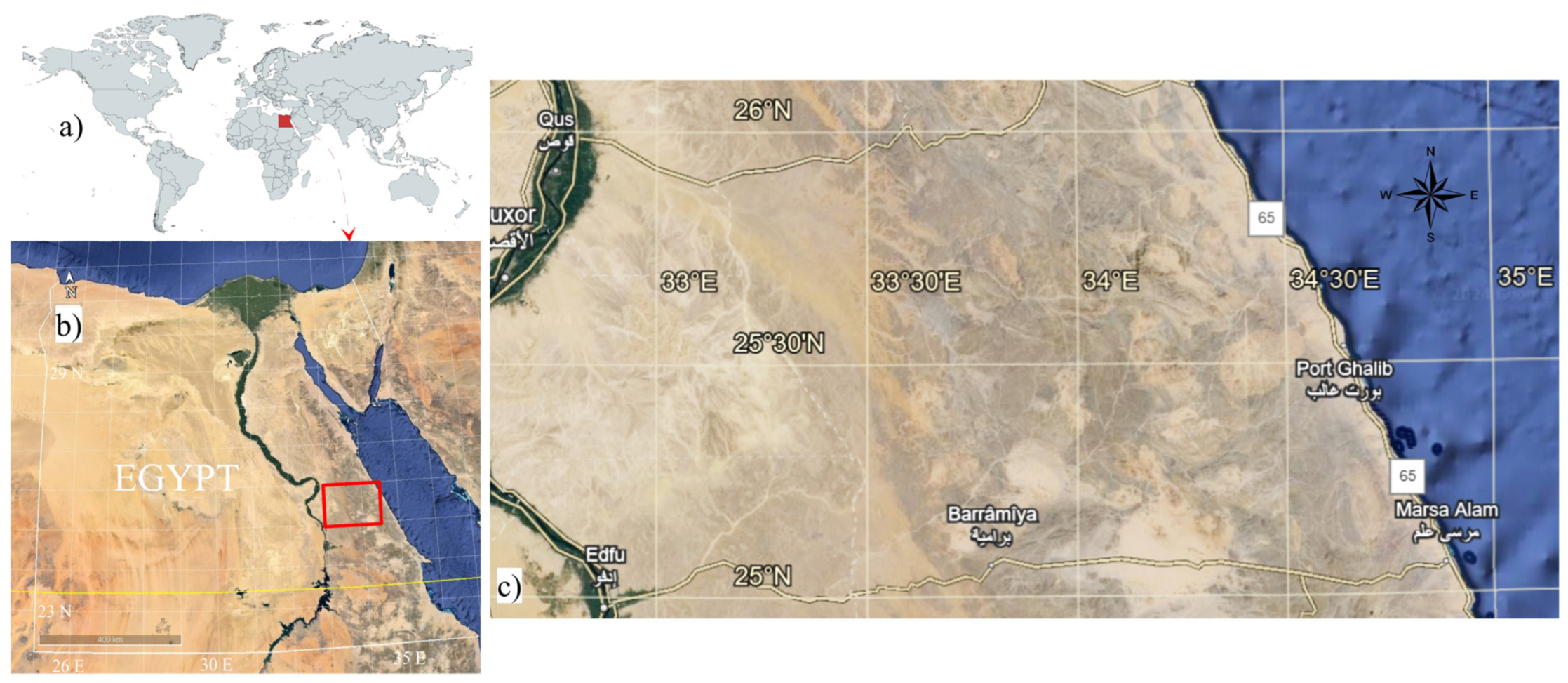


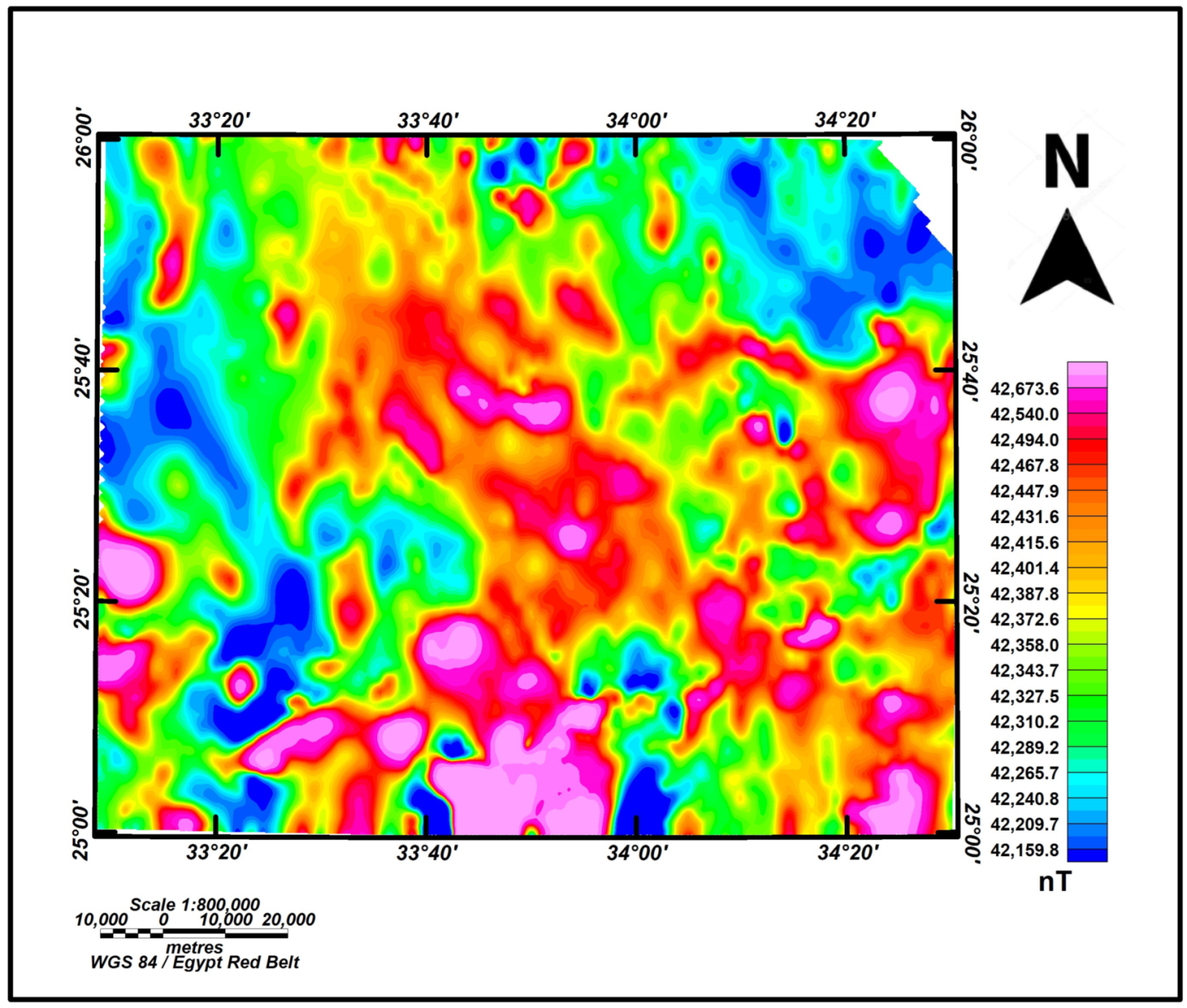
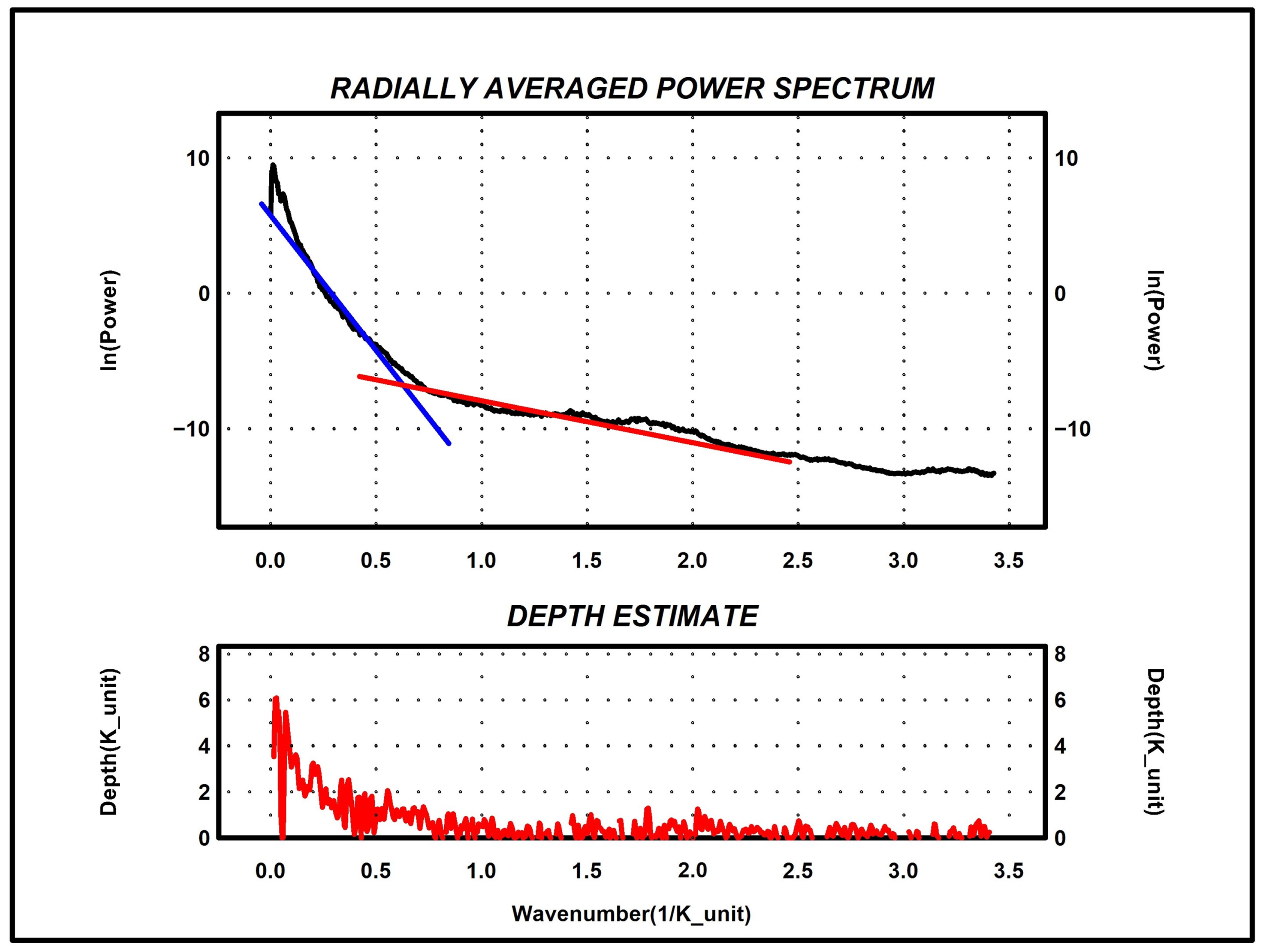


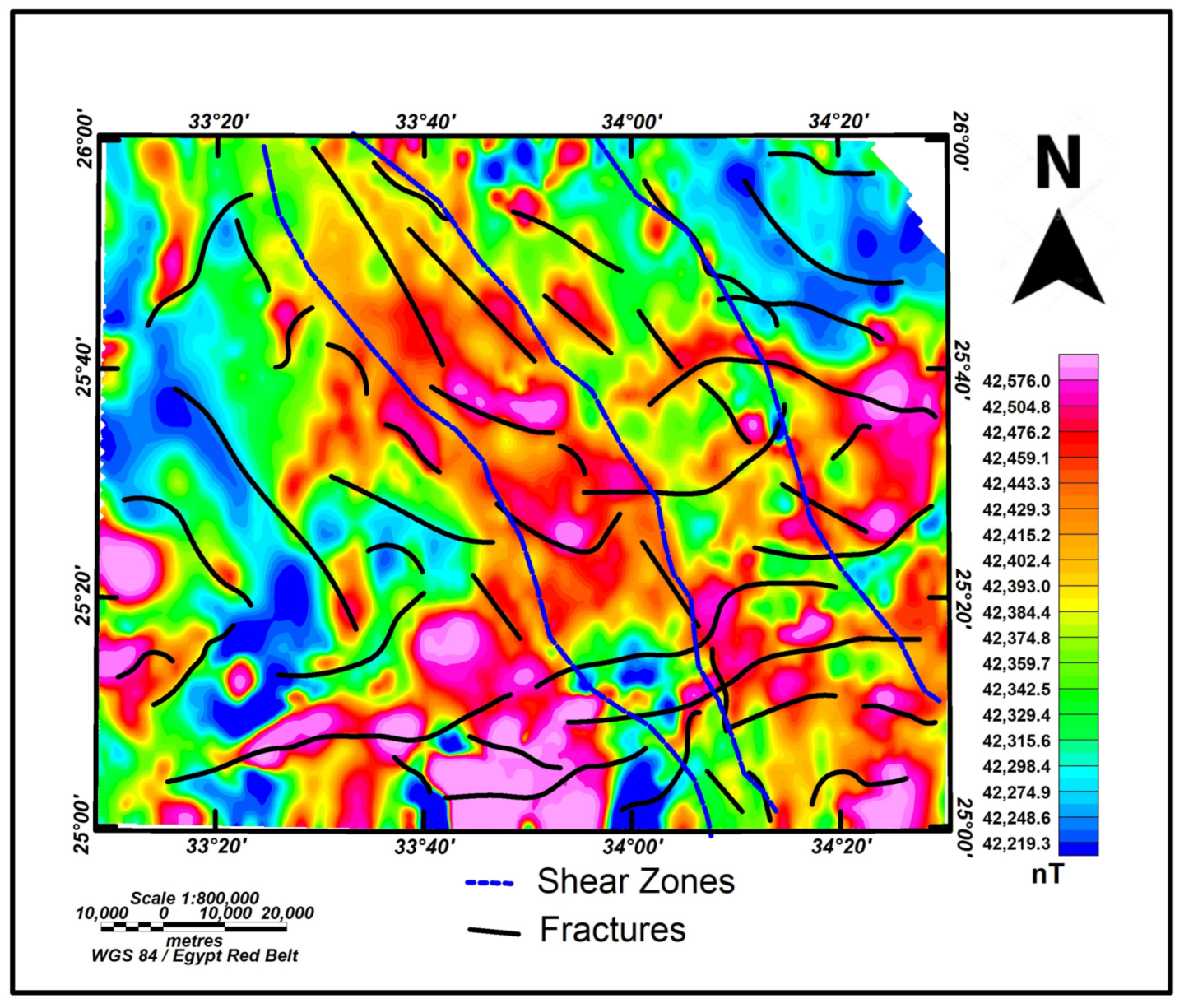

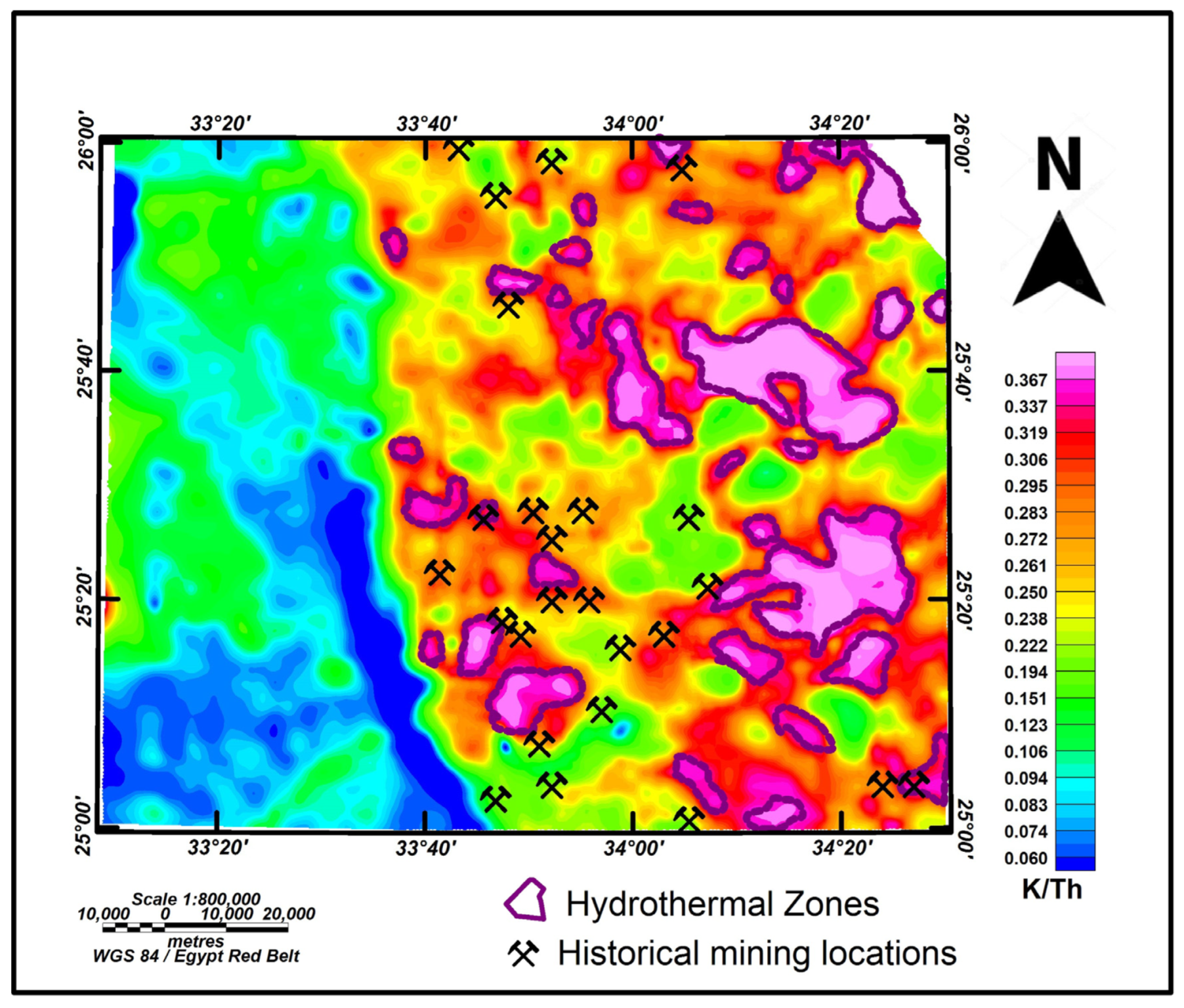


Disclaimer/Publisher’s Note: The statements, opinions and data contained in all publications are solely those of the individual author(s) and contributor(s) and not of MDPI and/or the editor(s). MDPI and/or the editor(s) disclaim responsibility for any injury to people or property resulting from any ideas, methods, instructions or products referred to in the content. |
© 2024 by the authors. Licensee MDPI, Basel, Switzerland. This article is an open access article distributed under the terms and conditions of the Creative Commons Attribution (CC BY) license (https://creativecommons.org/licenses/by/4.0/).
Share and Cite
Kotb, A.; Gaber, G.M.; Alzahrani, H.; Okok, A.; Elkhaliq, M.H.A.; Basheer, A.A. Unearthing Egypt’s Golden Legacy: Geophysical Insights and New Opportunities in the Central Eastern Desert. Minerals 2024, 14, 787. https://doi.org/10.3390/min14080787
Kotb A, Gaber GM, Alzahrani H, Okok A, Elkhaliq MHA, Basheer AA. Unearthing Egypt’s Golden Legacy: Geophysical Insights and New Opportunities in the Central Eastern Desert. Minerals. 2024; 14(8):787. https://doi.org/10.3390/min14080787
Chicago/Turabian StyleKotb, Adel, Gaber M. Gaber, Hassan Alzahrani, Abdurraouf Okok, Mohammed H. Abd Elkhaliq, and Alhussein Adham Basheer. 2024. "Unearthing Egypt’s Golden Legacy: Geophysical Insights and New Opportunities in the Central Eastern Desert" Minerals 14, no. 8: 787. https://doi.org/10.3390/min14080787
APA StyleKotb, A., Gaber, G. M., Alzahrani, H., Okok, A., Elkhaliq, M. H. A., & Basheer, A. A. (2024). Unearthing Egypt’s Golden Legacy: Geophysical Insights and New Opportunities in the Central Eastern Desert. Minerals, 14(8), 787. https://doi.org/10.3390/min14080787






